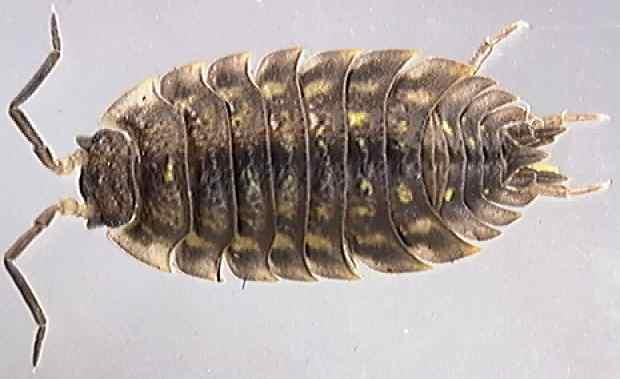Scientific classification:
• Kingdom: Animalis
• Phylum: Arthropoda
• Subphylum: Crustacea
• Class: Malacostraca
• Order: Isopoda
• Family: Onisciade
• Genus: Oniscus
• Species: Asellus
Habitat:
Ubiquitous throughout Britain, the common woodlouse (subspecies Oniscus asellus asellus) is one of the most widespread and common terrestrial arthropods in western Europe. The subspecies O. asellus occidentalis is found mainly in the south-west of Britain and western France.
The species is particularly fond of rotting wood and are one of the commonest species found under garden logs and stones in their range. They are also likely to be found in houses which have damp porches, in outhouses, back kitchens and so on.
Identification:
Up to 16 mm long and up to 6 mm wide.
Flat, brown-black with pale mottling and pale edges to the segmental plates. The body ends in a two-pointed segment - thetelson.
- shiny, even surface, greyish colour with white margins, sometimes with little yellow dots.
- wide oval shape, and the body is quite flat
- 3 segments of the flagellum, long antennae
- no significant protrusion or middle lobe on the head (compared to: Porcellio scaber, where you find an apiculate protrusion in the middle)
- no "lungs" ("white bodies") >>> Porcellio scaber has 2 pairs on the abdomen, ventral side.
- at first it doesnt run away, but clings on the surface (that's why it belongs to the "clinger type" isopods)
Oniscus asellus has a strong exoskeleton and seven pairs of legs, but are born with six pairs. They have antennae that reach about half of their body length, which they use to feel around in their dark environment.
Nutrition:
These woodlouse eat vegetables, various types of detritus such as dead plant and animal matter, including rotting wood.
Reproduction:
Oniscus asellus can reproduce both sexually and asexually. In sexual reproduction, which usually occurs in the dark, the male courts the female by waving his antennae at her. During the breeding season, reproductive females develop a 'brood pouch', which consists of overlapping leaf-like structures known as 'oostegites', which form a 'false floor' below the body. The fertilised eggs pass into this fluid-filled chamber, and the young crawl out of the brood pouch when they are fully developed
Role in the ecosystem:
They are very effective decomposers; this means they are often an integral part of a compost heap.
